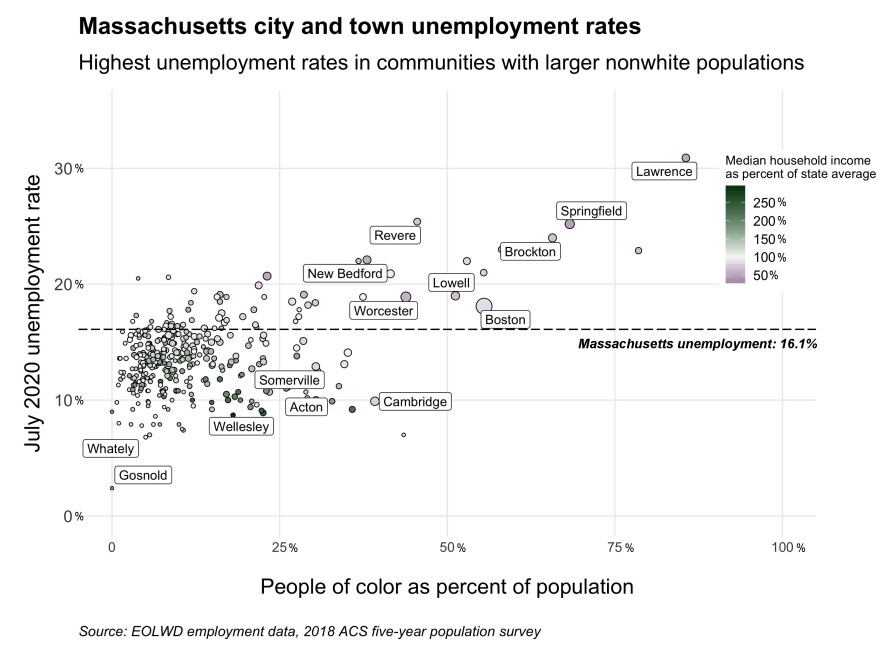The highest-in-the-nation unemployment rate in Massachusetts declined slightly in July, but the statewide figure masks wide disparities in the state of joblessness across different areas of the state.
Almost all of the labor market areas state officials track — a designation that sometimes lumps several communities together — experienced a sizable decrease in their unemployment rates from June to July, but every single one besides Nantucket still saw unemployment in the double digits, the Executive Office of Labor and Workforce Development announced Tuesday.
The state is more than five months into the public health emergency that prompted government-ordered business shutdowns and restrictions on public life to slow the spread of COVID-19, which has already killed more than 8,900 Bay Staters.
But while key health metrics have improved substantially from the spring and retailers on Tuesday reported they are all now back in business, albeit at reduced capacities, Massachusetts remains mired in a recession — an unsustainable dynamic that has also exacerbated existing inequities.
More than five dozen municipalities, including Boston, Worcester, Springfield and many other larger cities, experienced joblessness beyond the state average last month, according to state data analyzed by the News Service.
No community had a higher unemployment rate in July than Lawrence's 30.9%, nearly twice as much as the 16.1 percent reported for Massachusetts as a whole last week. That figure surpassed by several percentage points the second-highest rate of 25.4% in Revere.
Lawrence also saw the most dramatic change from last year, with its 25.6 percentage point increase — nearly sixfold — in unemployment from July 2019 to July 2020, outpacing any other Massachusetts location.
Revere and Chelsea also saw a 20 percentage point or more increase in their jobless rates compared to 2019, and jobless rates five months into the pandemic are above 20% in 17 of the state's tracked areas.
Much like the pandemic's health impacts, the economic upheaval has been disproportionately borne by communities of color.
Among the 10 Massachusetts cities and towns with the highest unemployment rates in July, eight — Lawrence, Springfield, Brockton, Lynn, Holyoke, Chelsea, Randolph and Malden — count a majority of their residents as nonwhite, Hispanic or Latino, U.S. Census Bureau data show.
Revere and New Bedford, the other two, still have populations of color well above the statewide average at about 45%and 38%, respectively.
While the state's capital also boasts a diverse body of residents, its workforce outlook has not been affected as acutely. Boston's unemployment rate declined slightly from 19.3% in June to 18.1% in July, higher than the state figure but still lower than many of the Gateway Cities to the north, south and west.
Its most immediate neighbors both fared better in terms of employment than the Massachusetts average, with Cambridge recording 9.9% unemployment and Somerville observing 12.9%.
Those with the lowest unemployment rates last month tend to be smaller, whiter or both. Of the 34 communities where the July unemployment rate hung in the single digits, only nine — including the city of Cambridge — have populations where at least one in five residents are people of color.
Even among the more comparably diverse cities and towns in that group, such as Acton and Aquinnah, none counted a majority of residents as nonwhite in the most recent five-year American Community Survey.
Gosnold, a miniscule town on the Elizabeth Islands of only a few dozen residents, reported the lowest joblessness rate in Massachusetts of only 2.4% in the latest state data, followed by Franklin County's Whately at 6.8% and Martha's Vineyard's West Tisbury at 7%.
Among communities with at least 10,000 residents, Wellesley — whose median household income clocks in at nearly two and a half times the statewide figure — had the smallest unemployment rate at 8.9%.
While Massachusetts employers added 72,100 jobs in July, the state posted the highest unemployment rate in the nation for the second month in a row.
The long-term outlook remains murky. Beacon Hill leaders may need to turn to tax increases and cuts to public jobs if they do not get another round of federal relief to help balance the state's budget, approaches that could have negative consequences on the employment front.
While the state appears to be managing the virus this summer, another surge of coronavirus transmissions could prompt a return to business closures, which in turn could force employers to backpedal toward layoffs.
The Massachusetts House and Senate approved wide-reaching economic development bills aimed at generating jobs by unanimous or near-unanimous margins, but lawmakers left Beacon Hill for the campaign trail at the start of August and the so-called jobs bill has failed to emerge from a conference committee for nearly a month.
Jobs bills are often approved in election years, and Gov. Charlie Baker first filed a proposal in early March before updating it with additional spending aimed at responding to the COVID-19 crisis.
Another major legislative proposal to authorize about $18 billion in borrowing for transportation projects, which could boost public works employment, is also hung up in conference committee after clearing the House and Senate, in differing forms, with overwhelming votes.




